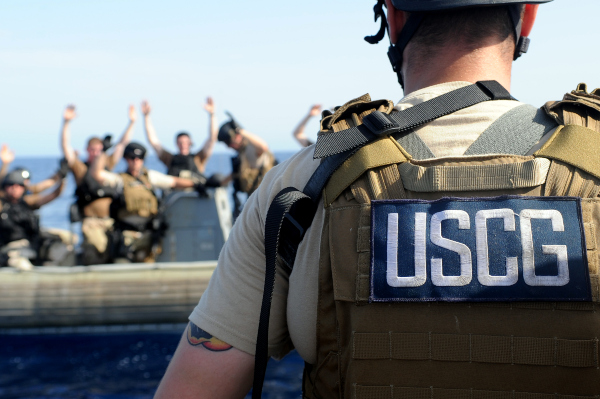Visit, board, search, and seizure (VBSS) is a term that the U.S. Armed Forces has for maritime boarding actions and tactics.
The objective of these teams is to combat terrorism, piracy, and smuggling activities.
Learn more about Visit, board, search, seizure (VBSS) programs of the Marine Corps, Navy, and Coast Guard.
Related Article: 5 Best Coast Guard Jobs
What is VBSS?
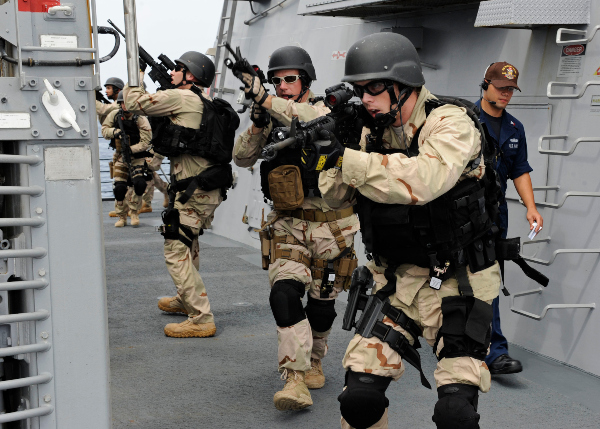
VBSS stands for visit, board, search, and seizure.
In other words, VBSS is a term of the U.S. military and law enforcement agencies to describe maritime boarding actions and tactics.
As a result, these teams have assignments capturing enemy vessels as well as conducting customs and safety inspections.
Visit, board, search, and seizure (VBSS) teams generally regulate and combat terrorism, piracy, and smuggling operations.
The United States Navy, Marine Corps, and Coast Guard all employ visit, board, search, and seizure teams as part of their overall mission.
All three military branches understand that oceans and seas remain the most vital component of global commerce.
Therefore, conducting maritime procedures to enforce safe and legal practices in major bodies of water is necessary to keeping the shipping lanes free and clear.
Though each military branch has slightly different training methods and demands, the principles are similar.
These teams practice tactical team movements, boarding and climbing onto ships, rappelling techniques, self-defense, and weapons handling.
Visit, board, search, and seizure training also focuses on physical and mental stamina.
Officials note that VBSS teams board ships where the ships crew has the upper hand.
Consequently, teams need to react well to their environment and observe crucial situational awareness.
It’s possible that physical conflict may occur on a foreign ship, which is why these teams are also trained well in self-defense and weapons handling.
Related Article – DEVGRU: 7 things you didn’t know about SEAL Team 6
VBSS Selection and Training
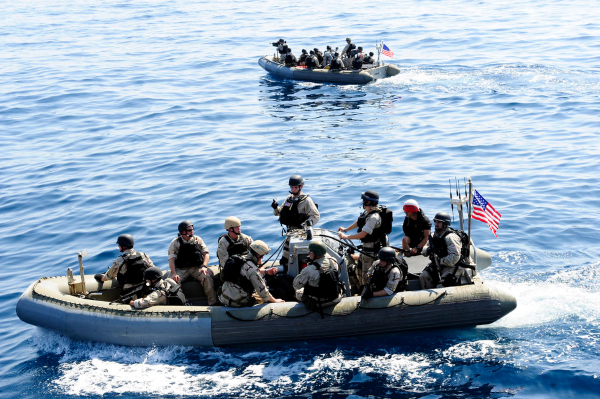
Visit, board, search, and seizure programs are available in the U.S. Navy, Coast Guard, and Marine Corps.
Here are some more details about each VBSS program, including selection and training:
Related Article: 13 Pros And Cons Of Joining The Marines
Navy VBSS Teams
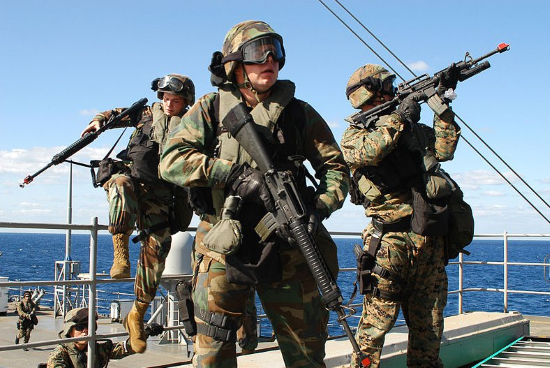
The U.S. Navy visit, board, search, and seizure team plays a role in maintaining security and freedom at sea.
The VBSS team is open to all sailors of the U.S. Navy but you need to get approval from your ship’s command beforehand.
Additionally, not everyone that qualifies for the VBSS school will make it past training.
The attrition rate for Navy visit, board, search, and seizure is 25-30%.
Prospective candidates receive specialized training at the Center for Security Forces (CENSECFOR).
The training consists of three courses with approximately eight weeks of initial instruction.
Some team members may receive additional training at the discretion of the U.S. Navy.
Navy VBSS training revolves around Close Quarters Battle (CQB).
Training includes hand-to-hand combat tactics, search procedures, tactical team movements, rappelling, searching, shooting, and arrest procedures.
Team members get equipped with M4 carbines as well as Mossberg 500 shotguns and Beretta M9 pistols.
Naval ships that support teams are generally smaller like cruisers or destroyers.
These teams enforce and combat illegal narcotics operations as well as piracy and arms trafficking.
Related Article – List of Coast Guard Bases in the US
Marine VBSS Teams
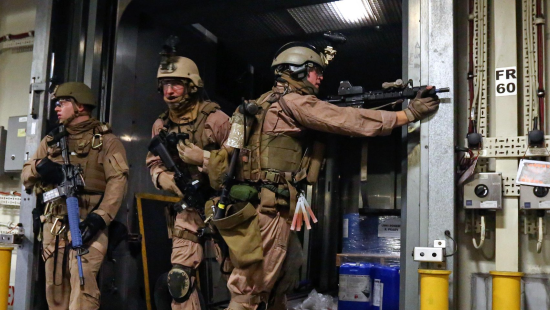
The United States Marine Corps also employs its own visit, board, search, and seizure program.
Marines from the 24th Marine Expeditionary Unit support VBSS training for the military branch.
There are several units that conduct VBSS under Marine Corps supervision.
The premiere VBSS force is called the ARG/MEU Maritime Raid Force (MRF).
Secondly, Fleet Antiterrorism Security Teams serve varying levels of VBSS duties.
The Marine Corps uses its various VBSS teams to capture enemy vessels as well as combat terrorism and piracy.
Conducting operations at sea present a whole level of new challenges for the Marines.
Therefore, these teams are highly trained to handle complex procedures and make sure that search and seizures are conducted safely and effectively.
The ARG/MEU Maritime Raid Force (MRF) consists of three platoons:
- Force Reconnaissance Platoon (Assault Element)
- Amphibious Reconnaissance Platoon (Support Element)
- Battalion Landing Team (Security Element)
The three platoons serve as the backbone of MRF and receive assistance from counter-intelligence, joint terminal attack controllers, and Coast Guard detachments.
Though Marine MRF is a conventional force it has the capabilities to carry out complex missions like special operations forces (SOF).
Coast Guard VBSS Teams
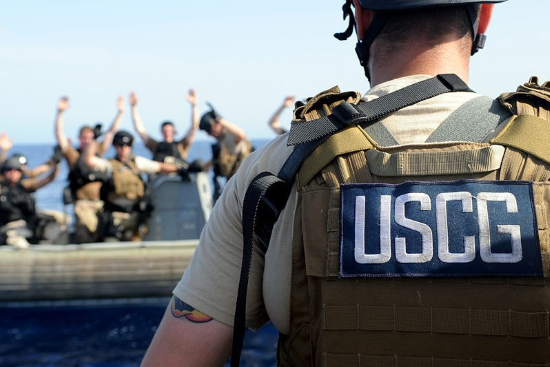
The United States Coast Guard also fulfills visit, board, search, and seizure operations.
It makes sense given that the Coast Guard is responsible for coastal maritime activities in the United States.
Furthermore, the USCG falls under the supervision of the Department of Homeland Security as opposed to the Department of Defense (like the Marine Corps and Navy).
As a result, Coast Guard VBSS teams may act as law enforcement within U.S. waters.
Coast Guard ship boarding teams are elite with several specialized units that act within the Deployable Operations Group.
Specialized Coast Guard VBSS teams have advanced boarding capabilities and training.
Therefore, teams have M16 rifles, Remington M870P shotguns, and SIG P229 pistols.
The Coast Guard may also call upon these teams to conduct at-sea safety inspections of civilian vessels.
Related Article – Navy SEAL Weapons and Gear: 24 Rifles, Handguns, Shotguns, and More
VBSS Weapons and Equipment
Military visit, board, search, and seizure teams utilize a variety of weapons and equipment for their operations.
The weapons include:
- M4 Carbines
- Mossberg 500 Shotguns
- Beretta M9 Pistols
- SIG P229 Pistols
- Remington M870P Shotguns
- MK-18 Rifle
- M-4 SOPMOD
- Kevlar Ballistic Plate Insert Body Armor
- Buoyant Tactical Vest & Life Preserver
Visit, board, search, and seizure teams also use the following types of equipment:
- Cruisers
- Destroyers
- MSST Over the Horizon Boat
- USN and USMC aircraft
Frequently Asked Questions (FAQ)
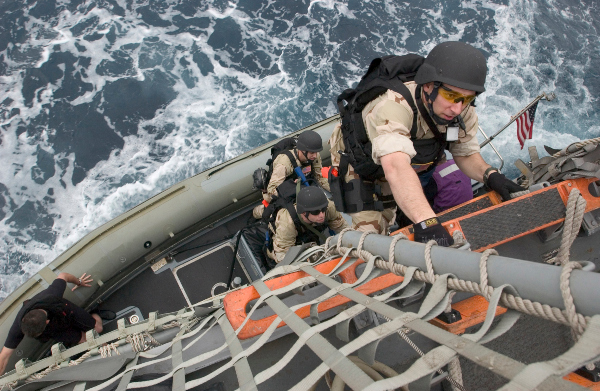
What else do you need to know about visit, board, search, and seizure teams in the U.S. Navy, Marine Corps, and Coast Guard?
Here are answers to some of the most frequently asked questions…
Related Article: 5 Best Navy Combat Jobs
1. Is working on a VBSS team dangerous?
Visit, board, search, and seizure teams work in hazardous environments.
The U.S. Navy recognizes the challenges and danger by offering VBSS team members hazardous pay even though they act as volunteers.
The reason VBSS operations are dangerous is it involves boarding foreign ships that are difficult to control.
There are many places on a ship to search and if the crew is trying to protect high valued narcotics or other illegal substances the conflict could turn deadly.
You never truly do not know what could develop as you search a suspicious vessel room-by-room.
It’s why specialized units like VBSS received thorough and detailed training due to their unusual obligations.
Also why VBSS teams are armed with powerful weapons and bulletproof gear.
2. Is VBSS considered Special Forces?
While a visit, board, search, and seizure team is not technically special forces the duties of the unit fall under many of the activities performed by SOF.
It also depends on the level of VBSS you are serving and the military branch.
For example, Navy VBSS teams assigned to non-compliant vessels that are greater than 25 feet of freeboard require handling by Special Operations Force (SOF).
Furthermore, the Marine Corps ARG/MEU sub-unit of MRF is a conventional force yet has the capabilities of many “SOF-like” missions.
3. What’s the pay like for VBSS members?
Interestingly enough VBSS teams are volunteers.
However, the U.S. Navy approved a measure over a decade ago to allow VBSS team members to receive extra hazardous pay.
The hazardous pay helps to support service members that put their lives at risk to keep the sea and the country safe from terrorism and drug smuggling.
While the hazardous pay is nice, most VBSS team members do not take on the added challenge for money.
Instead, they prefer the distinct honor and role of protecting our precious oceans.
4. What types of jobs could I qualify for in the civilian world?
Former VBSS team members of the U.S. Navy, Marine Corps, or Coast Guard make excellent candidates for maritime security.
There are five common types of maritime security including:
- Anti-Piracy
- Static Security
- Security Consulting
- Logistics
- Vessel Recovery
You’ll be surprised how much you can earn for a private military contractor.
It makes serving in the military as volunteer VBSS lucrative for after you leave the Armed Forces since your experience will be highly valued.
Related Article – Best Navy Jobs For Civilian Life
Conclusion
Visit, board, search, and seizure teams exist in the United States Navy, Marine Corps, and Coast Guard.
The military relies on these teams to conduct security checks of ships at sea.
As a result, these teams combat terrorism, piracy, and smuggling operations.
Serving a VBSS team is open to many individuals yet not everyone will pass the necessary training.
These teams operate in dangerous environments and must be prepared to defend themselves in the event of armed conflict.
- Ikon Pass Military Discount: Learn How To Save Big - January 31, 2025
- RTIC Military Discount: Find Out How To Save Big on Gear - January 30, 2025
- Traeger Military Discount: Learn How To Save Big on Smokers - January 28, 2025

